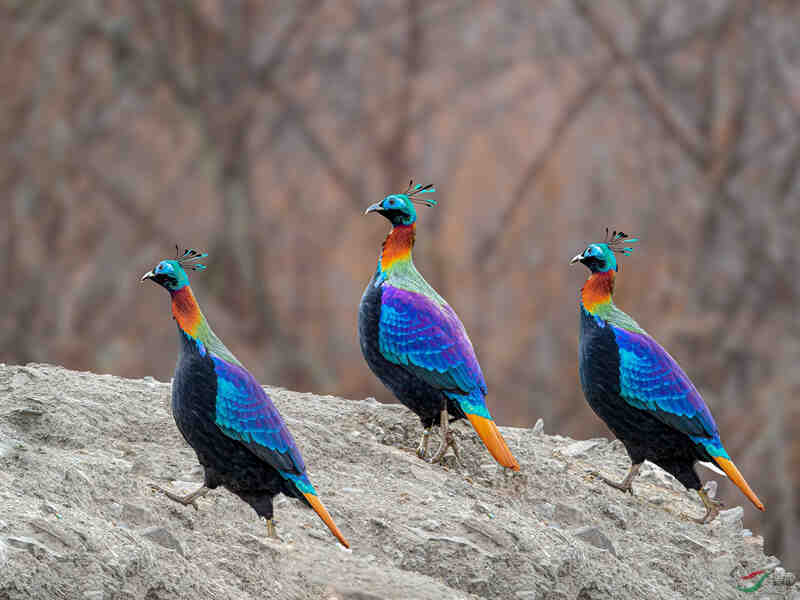Lophophorus impejanus
IUCN
LCBasic Information
Scientific classification
- name:Lophophorus impejanus
- Scientific Name:Nine-color bird,Lophophorus impejanus
- Outline:Landfowl
- Family:Galliformes Phasianidae Lycoris
Vital signs
- length:70cm
- Weight:2kg
- lifetime:7-20years
Feature
The image is very beautiful, especially the colorful male bird
Distribution and Habitat
The rufous-tailed pheasant is distributed in eastern Afghanistan, Pakistan, Kashmir, Nepal, Bhutan, northeastern India and northern Myanmar. In China, it is distributed in Dingjie, Tingri, Nyalam, Jilong, Yadong, Nyingchi, Medog, Zayu, Bomi and other places in southern and southeastern Tibet.
The rufous-tailed pheasant is a typical alpine chicken, living between 2500-4500 meters above sea level, in alpine coniferous forests, alpine meadows and rhododendron bushes shrouded in clouds and mist all year round. It is active during the day and roosts on steep rocks or in rhododendron bushes at night.
Appearance
The brown-tailed rainbow pheasant has a cluster of particularly elongated blue-green feather crests on its head. Its feather stems are thin and exposed, and the feather tips are spoon-shaped and curled forward, like velvet. It is very strange. It is the most beautiful feather crest among the rainbow pheasants. The feathers all over the body shine with a rainbow-like metallic luster, and the head is green; the bare skin around the eyes is sea blue; the back and sides of the neck are red copper; the back is copper-green, and the rest of the upper body is purple-blue-green, and the lower back is green. The waist and waist are white; the lower body is dark brown with obvious brown and white stripes; the tail is brown and red.
The plumage color of the female bird's whole body is elegant and delicate. The head, feather crown and upper body are all black with yellow or white stripes on the skin; the skin on the lower back is yellow with black concentric stripes; the chin, throat and f
Details
The foreign name of the brown-tailed rainbow pheasant is Himalayan Monal, and there is no subspecies.

The brown-tailed rainbow pheasant often moves in groups, and sometimes forms a large group of 20-30 in winter. The natural conditions there are very harsh. The whole summer is almost always spent in the cool drizzle and covered by clouds. Even sunny days are often surrounded by floating white clouds, and winter is covered by snow. However, it is born with the ability to adapt to the environment.
The food of the brown-tailed rainbow pheasant is mainly the tender shoots, leaves, twigs, tubers, fruits and seeds of shrubs and herbs, and sometimes insects and other animal food.
The breeding season of the brown-tailed rainbow pheasant is from April to June. It nests in forests with sparse vegetation under the forest. The nests are mostly placed on the ground or in large tree holes under the cover of rocks, shrubs or trees. The nests are relatively simple, usually in a slightly concave pit on the leaf litter. Each nest lays 3-8 eggs, which are light yellow or yellowish, with reddish brown and purple spots, and are 59.6-69.8 mm × 39.6-48.8 mm in size. The incubation period is 28 days.
The main endangering factor is the continuous expansion of cultivated areas and yak grazing areas, which seriously damages the habitat of the brown-tailed rainbow pheasant. In addition, factors such as excessive deforestation have reduced the habitat area. Hunted as food: indiscriminate hunting and nest destruction and egg collection also occur from time to time. The density in India and Nepal is about 0.15 per hectare, and in Pakistan it is as high as 0.34 per hectare. However, the number in China is extremely rare, and only sporadic individuals can be seen, and the total number is estimated to be less than 1,000.
Listed in China's national key protection level: Level 1 Effective year: 1989
Listed in China's Red Book of Endangered Animals Level: Rare Effective year: 1996
Listed in the "Red List of Endangered Species of the World Conservation Union" (IUCN) 2016 ver 3.1-Least Concern (LC).
Protect wild animals and eliminate game.
Maintaining ecological balance is everyone's responsibility!








